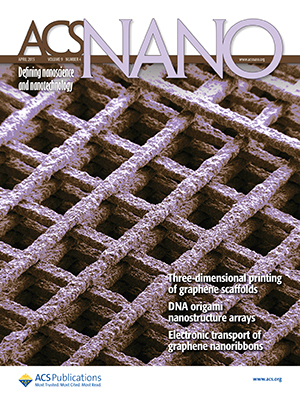Printing 3-D Graphene Structures for Tissue Engineering
A new ink formulation allows for the 3-D printing of graphene structures
Ever since single-layer graphene burst onto the science scene in 2004, the possibilities for the promising material have seemed nearly endless. With its high electrical conductivity, ability to store energy, and ultra-strong and lightweight structure, graphene has potential for many applications in electronics, energy, the environment, and even medicine.
Now a team of Northwestern University researchers has found a way to print three-dimensional structures with graphene nanoflakes. The fast and efficient method could open up new opportunities for using graphene printed scaffolds regenerative engineering and other electronic or medical applications.
 Led by Ramille Shah, assistant professor of materials science and engineering at the McCormick School of Engineering and of surgery in the Feinberg School of Medicine, and her postdoctoral fellow Adam Jakus, the team developed a novel graphene-based ink that can be used to print large, robust 3-D structures.
Led by Ramille Shah, assistant professor of materials science and engineering at the McCormick School of Engineering and of surgery in the Feinberg School of Medicine, and her postdoctoral fellow Adam Jakus, the team developed a novel graphene-based ink that can be used to print large, robust 3-D structures.
“People have tried to print graphene before,” Shah said. “But it’s been a mostly polymer composite with graphene making up less than 20 percent of the volume.”
With a volume so meager, those inks are unable to maintain many of graphene’s celebrated properties. But adding higher volumes of graphene flakes to the mix in these ink systems typically results in printed structures too brittle and fragile to manipulate. Shah’s ink is the best of both worlds. At 60-70 percent graphene, it preserves the material’s unique properties, including its electrical conductivity. And it’s flexible and robust enough to print robust macroscopic structures. The ink’s secret lies in its formulation: the graphene flakes are mixed with a biocompatible elastomer and quickly evaporating solvents.
“It’s a liquid ink,” Shah explained. “After the ink is extruded, one of the solvents in the system evaporates right away, causing the structure to solidify nearly instantly. The presence of the other solvents and the interaction with the specific polymer binder chosen also has a significant contribution to its resulting flexibility and properties. Because it holds its shape, we are able to build larger, well-defined objects.”
Supported by a Google Gift and a McCormick Research Catalyst Award, the research is described in the paper “Three-dimensional printing of high-content graphene scaffolds for electronic and biomedical applications,” published in the April 2015 issue of ACS Nano. Jakus is the paper’s first author. Mark Hersam, the Bette and Neison Harris Chair in Teaching Excellence, professor of materials science and engineering at McCormick, served as coauthor.
 An expert in biomaterials, Shah said 3-D printed graphene scaffolds could play a role in tissue engineering and regenerative medicine as well as in electronic devices. Her team populated one of the scaffolds with stem cells to surprising results. Not only did the cells survive, they divided, proliferated, and morphed into neuron-like cells.
An expert in biomaterials, Shah said 3-D printed graphene scaffolds could play a role in tissue engineering and regenerative medicine as well as in electronic devices. Her team populated one of the scaffolds with stem cells to surprising results. Not only did the cells survive, they divided, proliferated, and morphed into neuron-like cells.
“That’s without any additional growth factors or signaling that people usually have to use to induce differentiation into neuron-like cells,” Shah said. “If we could just use a material without needing to incorporate other more expensive or complex agents, that would be ideal.”
The printed graphene structure is also flexible and strong enough to be easily sutured to existing tissues, so it could be used for biodegradable sensors and medical implants. Shah said the biocompatible elastomer and graphene’s electrical conductivity most likely contributed to the scaffold’s biological success.
“Cells conduct electricity inherently — especially neurons,” Shah said. “So if they’re on a substrate that can help conduct that signal, they’re able to communicate over wider distances.”
The graphene-based ink directly follows work that Shah and her graduate student Alexandra Rutz completed earlier in the year to develop more cell-compatible, water-based, printable gels. As chronicled in a paper published in the January 2015 issue of Advanced Materials, Shah’s team developed 30 printable bioink formulations, all of which are compatible materials for tissues and organs. These inks can print 3-D structures that could potentially act as the starting point for more complex organs.
“There are many different tissue types, so we need many types of inks,” Shah said. “We’ve expanded that biomaterial tool box to be able to optimize more mimetic engineered tissue constructs using 3-D printing.”